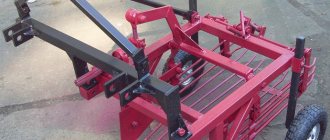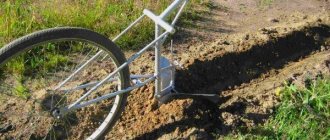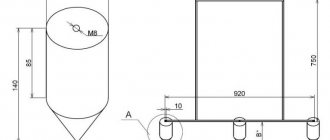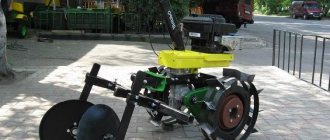Attachments for various agricultural machinery can significantly expand the use of these units in rural areas. The presence of a walk-behind tractor or mini-tractor (for example, Russian-made) does not mean that you will be able to perform absolutely any tasks on earth.
For example, mowing lawns or planting potato tubers will not be possible for you without the use of additional equipment.
In many ways, the land is cultivated specifically for planting potatoes, because it is not for nothing that it is called “second bread.” Of course, many are accustomed to planting potatoes with a walk-behind tractor (for example, Don), manually, or using a potato planter for a mini tractor, but you can think about making a potato planter with your own hands.
This is a rather painstaking task, so you need certain knowledge and skills before starting work.
Analogs
Due to the fact that the average price for potato planters can reach 30 thousand rubles, not every owner of a plot of land is ready to spend that amount on a simple device.
Making this device yourself is quite simple. How to do this correctly? The most common method of assembling this equipment is carried out according to the following algorithm: 1. A metal frame is used as the base of the potato planter. It is made from pipe sections with a cross section of 40x40 mm. Steel blanks are welded together to form a frame with longitudinal side members. 2. The frame is equipped with fastening elements for installing working equipment. Components such as the locking fork, the bracket for the closing discs and the wheel attachment are welded to the front. A strong round pipe with bearings welded along its edges is used as the axis of the bridge. 3. The tuber-conducting element is being installed. For this, a pipe of decent diameter, at least 10 centimeters, is used. The chain conveyor, which moves the tubers, is not welded to the top, and the coulters, which are responsible for the formation of the furrow, are not welded to the bottom. 4. A container for seed material is made from tin or thin metal. You should not choose thick-walled steel, as this will greatly burden the structure. 5. The closing discs are welded to the frame and the wheelset is installed. The resulting mechanism is ready for testing and subsequent use. A homemade potato planter is one of the most popular types of equipment designed for successful farming. Most current land owners prefer to use units made with their own resources and resources. The manufacture of this device does not require professional engineering skills and is within the capabilities of every mini-tractor user. A homemade device helps to cope with decent amounts of work and is practically not inferior in performance to industrially produced models.
To study the issue in more detail, you need to watch a video of creating a potato planter for a mini tractor with your own hands:
How to assemble a two-row potato planter yourself
Assembling a potato planter for a mini-tractor must begin with installing the frame. It is made from channel No. 8. Two spars are attached to the frame for welding subsequent parts and they are reinforced with three cross members.
Detailed drawing of a potato planter for a mini tractor
In the front part of the side members, fastenings are welded to them, with the help of which the planter will cling to the tractor. Then the spars are reinforced with two inclined metal beams, to which a hopper for planting material will subsequently be welded. A plow or coulter and an axle for one wheel must be attached to the bottom of the frame.
Drawing of a potato planter for a mini tractor and walk-behind tractor
The potato container is made from pieces of plywood at least 1.5 cm thick. First, parts of the desired shape and size are cut out, then connected to each other with metal corners. Plywood is impregnated with drying oil and painted with water-based paint. The inside can be lined with softening material, such as rubber, to prevent damage to the tubers.
Purchased potato planter for a mini tractor in the photo
A washing machine tank is perfect for containers for potatoes. It is better to make the wheels for the planter wide so as not to trample loose soil. The role of the seeder will be performed by a metal pipe with a hole of at least 10 cm. You also need to provide a workplace for an assistant who will monitor the process.
Photo of a homemade two-row potato planter
Also read:
Now you know how to make a homemade potato planter for a mini tractor with your own hands. The video and drawings from this article will help you maintain the exact dimensions, taking into account the model of your mini-tractor. Most often, potato planters are made for the T-25 or MTZ-82 tractor, so take into account the model of the main equipment.
Specific points when using the planter
Due to the rather impressive weight of the potato planter, it is necessary to mount a ballast weight on the front part of the walk-behind tractor or mini-tractor during its operation. Otherwise, the equipment may become unstable.
For the convenience of the operator, it is necessary to equip the unit with footrests, stepladders and a seat, or better yet, an adapter for a walk-behind tractor.
The frame for the operator's seat is welded from welded corners, and then the product is given its final appearance and comfort using boards, foam rubber and leatherette.
The seatpost is attached using angles to the welded side members, after which a convenient footrest is installed for comfortable operation of the seeder.
The principle of working with the equipment is quite simple. Sufficient quantities of potatoes are placed in a container for planting material and a walk-behind tractor or walk-behind tractor can start moving at a speed of 1 kilometer per hour. This low speed must be maintained throughout the route. The seeder sends seed tubes into the pipes one potato at a time, while the driver supports the movement of the equipment. This is how the seed is planted.
Covering the planted potatoes with soil and forming the ridge of the furrow is the task of sealing discs, which do an excellent job of it. Covering with soil occurs because the discs are at an angle to the furrow. Rotating, it shifts layers of earth and fills up potato seeds.
If backfilling of planting material with soil occurs incorrectly, then there is always the possibility of adjusting the operation of the discs. You can loosen the stepladders, then move the disc stands, in this way their depth is adjusted. By turning the racks around the axis, you can change the angle of the disks. There are also four special pins for adjusting the position of the disks in the plane. They can be moved to the side relative to the other disks.
And one more important point. The potatoes are planted, the furrows are sealed, but noticeable traces of the planter wheels are visible on the field, which, although they are made in the form of cylinders of considerable width, are nevertheless compacting the earth. In order to remove this defect, cultivation paws were attached to the planter. They loosen the soil following the planter and completely eliminate wheel marks.
The depth of penetration of these paws into the soil can also be adjusted without much difficulty.
Homemade potato planter photo
The photo shows an example of how to make a single-row potato planter with your own hands.
|
Engine characteristics
The potato planter itself is semi-mounted equipment and does not have an engine. However, the power unit is present in the vehicle that moves the device. For the middle class of mechanisms for planting tubers, a number of requirements for the motor have been established. This should include
- engine power, which should be in the range from 10 to 14 hp;
- the working volume of the cylinders should be -0.45 l;
- crankshaft rotation speed - 3000 rpm.
The level of fuel consumed should be about 255-265 g/kWh. It is this consumption rate that will allow the farmer to most efficiently carry out work on a plot of up to 30 acres.
Necessary materials
A potato planter can be made at home, because it does not require any rare components or special tools. Homemade potato planters, drawings of which can be freely found on the Internet, are made from the following materials:
Frame
- a frame consisting of steel pipes and angles for attaching other structural parts to it;
- reservoir (hopper) for potato tubers;
- gears that will power the entire landing mechanism;
- steel parts that form the holes in which the potatoes will be planted, as well as burying them after that;
- wheelbase.
These are all the components of the design of a homemade potato planter that need to be made or taken from old agricultural equipment. Naturally, the work cannot be done without a welding machine, an angle grinder, as well as the presence of various channels, spars and other related materials.
You can also make a fertilizer dispenser for a potato planter with your own hands, with the help of which you will simultaneously plant and fertilize the holes. This is a fairly common phenomenon, because when planting by hand, they often use a mixture of ash and chicken droppings, or manure, with the addition of phosphate fertilizers.
This, of course, is not necessary, but additional fertilizer will contribute to the rapid ripening of the crop, which is important in our regions where the summer is quite short.
You can find out why you need a snow blower at your summer cottage in this article.
For example, read the article about the Honda snow blower - a description of the model range, main characteristics, advantages and disadvantages of the models.
A - detailed instructions on how to make a snow blower for a walk-behind tractor yourself.
Review of potato planters for a walk-behind tractor and how to make it yourself
A potato planter is an agricultural unit that can significantly increase labor productivity when planting potatoes. The process requires less effort and time, unlike manual planting. As a means of small-scale labor mechanization, a potato planter for a walk-behind tractor is aimed exclusively at summer residents and other small agricultural producers. For such users, the cost of the unit is of paramount importance. We will tell you in detail how to save money by assembling the device yourself.
User manual
Recommendations for using potato planters are quite similar to each other, differing only in minor points. You cannot put more fruits into the tuber hopper than stated in the technical specifications of the unit. The potato planter cannot be transported when it is fully loaded.
Before starting work, you need to make sure that the wheel tracks of the mini tractor and the potato planter completely coincide.
- It is necessary to carry out preliminary preparation of the soil before using a potato planter on it. This means that the land should be plowed and have a loose structure.
- After passing the first row, you need to adjust the degree of immersion of the coulters, the depth of laying potato tubers, as well as the distance between them.
- It is necessary to inspect the working components of the unit every 8 hours of continuous operation.
- After completion of the work, the unit must be returned to normal condition, i.e. clean it from dirt, remnants of vegetation, etc.
- In addition, you need to inspect the fastening connections. If necessary, you need to tighten the bolts and also check the condition of the wheels.
- If you will not use the potato planter for some time, you need to reduce the tire pressure and also remove the roller chains that are located on the planting devices.
As we can see, the operation of the unit is quite simple to implement, no different from the recommendations for other technical means.
Purpose and potato planters
A modern potato planter for a mini tractor is a mounted device that is attached to the tractor.
Today, the market for these products offers a large range of these devices. The main difference between this technique is labor productivity. The price of these models is also different and directly depends on the performance. Today's models of potato planters can be divided into types:
- Small planters. They are mainly used with a walk-behind tractor.
- Potato planters for mini tractors. These devices are used with a tractor, and they come in single and double rows.
- Potato planter for medium power tractors. They come in three and four rows.
- Potato planter for heavy tractors. These devices come in six rows or more.
You should choose which one you need based on the scale of the work ahead, as well as the type of your tractor (its power, model). For a small agricultural farm, a potato planter for a mini tractor may be quite suitable, but for large farms with huge areas of land, more powerful models are used.
Types and types of potato planters
Potato planters vary in size and type of tuber feeding.
To size
Small-sized ones are used for planting potatoes in a summer cottage or garden plot. The design provides a regulator for the depth and height of the earth ridge, which is formed when the soil is raised. Small-sized devices are suitable for walk-behind tractors. The hopper volume of such potato planters does not exceed 35 liters. The planting rate is 0.1-0.2 ha per hour.
For medium potato planters, the hopper volume reaches 45 liters, and the productivity is 0.25 hectares per hour. Such planters are installed on heavy walk-behind tractors and mini tractors.
Large ones are used for planting over large areas. Their bunker is correspondingly large and is loaded using a dump truck.
By type of seed supply
In a unit with a spoon system, potatoes are fed for planting using a structure of spoons attached to a belt.
The flat belt system consists of horizontally located belts between two main ones. This device produces a single-row planting.
The multi-belt system allows you to plant potatoes in two rows. Each row is served by several belts - up to 28 pcs.
Reference. When deciding which potato planter is better - belt or chain - you should take into account the fact that with the second, due to vibrations during operation, potatoes fall from the plate back into the hopper, and the planting turns out to be uneven.
Homemade potato planter.
Potato planter for mini tractors 2MBS-1
The manufacturer of this potato planter is Xingtai.
The maximum power of this equipment is 4.8 km/h. It is single-row and the depth of planting tubers using this technique is 80-120 mm. Has two containers, one for seed potatoes, the second for fertilizers. Fertilizers are applied to the soil at the same time as planting. A box for potatoes is 40 kg, for fertilizers 25 kg. The planting pitch between tubers will be 250-270 mm. The efficiency of labor productivity is 0.1-0.3 hectares per hour. A mini tractor for such a planter needs 12-18 hp. This potato planter weighs 105 kg. The price for such equipment ranges from 17,000 to 19,000 in Russia. If you buy directly from the manufacturer, the price will be lower. Companies that deal with specialized equipment make their own markup, which includes additional shipping costs and other expenses.
TOP 3 factory models of potato planters
Among the factory models of potato planters for walk-behind tractors, the following are the most popular:
Important! The name of these models stands for single-row potato planter (PT), the number “1” after the hyphen. The additional letters “M” and “A” indicate modifications (improvements) of previously released models.
- Type – single-row, trailed;
- Weight –25 kg;
- Track – 700 mm;
- Hopper capacity – 40 l;
- Productivity – 0.15-0.2 g/hour;
- The required power of the walk-behind tractor is from 6 hp;
- Price – 12000-14500 rub.
Potato planting unit KS-1A
- Type – single-row, trailed;
- Weight –33 kg;
- Track – 600 mm;
- Hopper capacity – 34 l;
- Productivity – 0.25 g/hour;
- The required power of the walk-behind tractor is from 6 hp;
- Price – 15,000-16,000 rubles.
KSM-1A – productive and convenient potato planter
- Type – single-row, trailed;
- Weight – 44 kg;
- Track – 600 mm;
- Hopper capacity – 41 l;
- Productivity –0.25 g/hour;
- The required power of the walk-behind tractor is from 6 hp;
- Price – 15500-16000 rub.
All these models work well with walk-behind tractors, both domestic (MTZ, Neva, Salyut) and foreign-made (Viking, CAIMAN, Daewoo).
Related article: Ridomil Gold MC for potatoes: instructions and dosage
Important! You can buy one of the models listed above in almost any large and medium-sized Russian city. But the most favorable prices are in such large cities as Moscow, St. Petersburg, Yekaterinburg, Novosibirsk. This is explained by high competition among a large number of sellers: firms, private entrepreneurs, which causes a wide variety of prices, seasonal discounts, and the possibility of purchasing equipment in installments or on credit.
Thus, a homemade inexpensive potato planter for a walk-behind tractor is a very convenient, easy-to-use unit, but at the same time it greatly facilitates the work of a summer resident or small farmer. Made from materials available to everyone, such a homemade product, compared to store-bought counterparts, will have a cost several times lower, while not being inferior to them in quality and reliability.
Additional Tips and Warnings
In general, the process of planting potatoes using a homemade potato planter is as follows:
- Potatoes are poured into the tuber tank. You need to put a couple of bags of potatoes on top so as not to waste time when the tubers in the bunker run out.
- One person sits on a seat located on the potato planter, and the second person sits on either a mini tractor or a walk-behind tractor (see).
- Movement should be carried out at a speed of no more than 1 km/h.
- A person sitting on a potato planter alternately throws tubers into tuber pipes located on both sides.
- After the tubers fall into the holes, they need to be covered with earth. It is for this purpose that discs were designed, which cover the holes with earth while rotating.
You can change the depth of removal of the top layer of soil that these discs produce. To do this you need:
- Adjust the stepladders that press the support to the posts by loosening them.
- You can slightly change the angle at which these disks are located. To do this, you need to turn them a little in the right direction.
After completing the planting process, all that remains is to remove the traces left by the walk-behind tractor and potato planter. In this case, baking powder will help us, i.e. cultivator blades located on stands. By the way, the degree of their immersion in the ground can also be adjusted.
A homemade potato planter with detailed dimensions can be a great way to save money that would inevitably be incurred if you purchased a potato planter from a specialty store.
Considering that the average cost of this unit is about 15 thousand rubles, this saving looks especially justified. At the same time, there are no special costs for the necessary materials during production, because the components are used from old, worn-out units.
Making a potato planter for a walk-behind tractor
To make this useful equipment you will need to assemble a frame. It is made quite simply from a steel channel of size 8. Since the planter was designed for small equipment - walk-behind tractors, the bunker, made of plywood 8-10 mm thick, will be small - fifteen to twenty kilograms.
An elevator is mounted in the bunker, fixed in a vertical position. The elevator is equipped with bowls five to eight centimeters in diameter. In order for the mechanism to work, it is connected to the drive wheel using a chain drive.
To remove the seed material, a seed tube is used, strengthened under the elevator, pressed by a raking part.
An eight-centimeter sprocket, attached to the mechanism, is responsible for the chain drive, connected by a chain to the sprocket on the walk-behind tractor, which measures sixteen centimeters in diameter.
Thanks to this system, in the manufacture of which you can use a regular bicycle chain, a transmission operates that allows you to automate the planting of potatoes, while the distance between units of planting material is 35 centimeters.
How the device works
Not a complicated operating principle
A do-it-yourself potato planter for a mini tractor will not be inferior to purchased options if all the features are taken into account, from the choice of materials to the operating principle of all mechanisms. The operation of such a device is based on the simple interaction of two stars and a chain with blades:
- While the device is moving, the wheel axle rotates.
- A star is installed on the wheel axle (as on old domestic combines), which also rotates.
- Vertically, above one star there is another. Between them there is a chain with blades, which during movement captures and scatters the tubers.
You can also make discs that will dig ditches along a certain track width. In addition, the container itself where potatoes are transported can be made in any volume that its owner wants. Limitations are present only in the availability of material and human desires.
Design Rules
Robust design
It is best to design the device using ready-made drawings, which already have all the necessary dimensions and a sketch of the device itself. The fact is that most of the devices that can be seen in the video taken by the farmers are suitable for any vehicle. Potato planter for tractor T 40, T80 (82), Neva, Salyut and other brands and models, assembled taking into account the same features
Most often, the device is assembled like this (single-row or double-row type of device does not matter):
- 2 spars are welded to the frame of the device, which is channel No. 8. The structure is strengthened with transverse ribs.
- Fastenings are welded to the front part of the side members, with the help of which the device will be connected to the T 40, T 80, MTZ tractor, etc. (despite the multifunctionality of the device, it is better to review/modify the possibility of connecting it to the tractor).
- 2 metal strips 25-30 mm wide are welded to the side members. The length is taken from the dimensions in the drawing. Place them at an angle.
- A hopper for planting material is welded to the other end of the metal strips.
- A plow or discs are welded to the bottom of the frame.
Potato containers can be made from either metal sheets or plywood.
The main thing is that the structure is strong, but not heavy. It is easier to work with wood whose thickness is no more than 1.2 cm. According to the available drawings and the dimensions indicated in them, it is necessary to cut out the walls of the tank and connect them into one structure, securing them at the corners with a metal corner. To avoid damage to the potatoes, foam rubber or other softening material can be placed on the inside of the tank.
The wheels of the device can be taken from a gas cylinder by cutting off 2 transverse rings from it. The main problem is the stars. A two-row machine must have a certain number of teeth. On the stars, their number should be 40 and 15. It is better to find ready-made parts from old combines. So, installing the chain will not be difficult. The blades are attached directly to the chain. They can be made from thin sheet metal or wire. The second option is simpler. The landing pitch is adjusted by the distance of the blades from each other. It is most advisable to install them at a distance of 25-27 cm.
DIY making
You can choose a potato planter and other necessary attachments in a specialized store, or you can make such a device at home. You just need to have some plumbing skills and purchase the necessary materials to make a mounting device for a walk-behind tractor.
Tools and materials
To make a potato planter with your own hands, you will need to purchase:
- Axles, bicycle chain (or chain from a car engine), bearings for wheel movement, making a chain elevator.
- Metal sheet for making a bunker.
- Square or round metal profile for mounting a frame holder and other purposes.
- Welding machine for firmly connecting potato planter elements to each other.
- Several electrodes for welding.
- Grinder and discs for cutting metal sheets into the required parts.
- An electric drill and drill bits for it for drilling work.
- Fastening elements to add strength to the device.
- Nuts and screws for mounting the structure.
- Wire (several meters) for fastening some elements of the device.
- Sandpaper or file for sanding and cleaning parts.
Before you start assembling the potato planter, you need to carefully study the drawing, think about the dimensions of the future device, its appearance, and the method of attachment to the walk-behind tractor. The dimensions of the planter should not be very large so that the design does not become too bulky.
The volume of the bunker for filling tubers is determined based on the calculation of the double length of the bed. The volume of the container should be enough for a walk-behind tractor with a bunker filled with potatoes to pass two furrows and return to the place of re-loading.
Assembly steps
The production of a potato planter takes place in several stages:
- Frame construction is the simplest part of the nozzle assembly stage. To construct a frame, two long blanks are cut from a round or square profile for its longitudinal part, and two shorter ones for the transverse part of the frame. The optimal size of the frame base is 60 by 20 cm. Places of future welding of metal parts are cleaned with sandpaper or a file, processed and welded. The seams are also cleaned using sandpaper.
- Making a bunker . The metal sheet is cut into the necessary parts using a grinder. The parts are cleaned with sandpaper, processed and welded together in the shape of an inverted pyramid. The process of making a container for potatoes can be simplified by using a tank from a broken washing machine as a hopper. The body of the container is fitted to the designed frame, determining the optimal location for the location of the axis of the planter wheels so that the center of gravity of the hopper with potatoes loaded into it is 6-10 cm in front of this axis. This design solution will reduce part of the load on the walk-behind tractor during operation.
- Installation of axle for wheels and bearings . At this stage, you need to mark and try on areas for attaching bearings and mounting the axle. Bearings are placed on the frame using metal corners. For structural strength, it is better to choose steel parts. After this, the frame must be rotated, and the pipe must be firmly attached to the corners by welding. The weld seam is secured using pads. The pipe will house the wheel axle. In its cavity, the pipes secure support bearings, placing one at a time.
- Attaching vertical posts . Two metal posts are welded to the base of the frame, positioning them vertically. These structural elements support the attached bearings that support the upper axis of the sprocket holding the chain lift. The bearings are attached using clamps. To prevent dirt and soil from getting inside the bearing, you need to choose those that have a closed cage design. The optimal solution is to cover the axles with protective boots. After this, determine the location of the upper and lower sprocket using a plumb line. A grinder is used to make a cut in the pipe at the base of the frame. Then install the lower sprocket on the axle. Put a chain on the structure and pull it up strongly. Determine the location for attaching the upper axle and sprocket. Install the axle and bearings for the upper assembly and mount the device on vertical posts.
- Wheel fastening . To improve the feeding of potato tubers from the hopper, it is necessary to partially supplement the chain drive. When the walk-behind tractor is operating, the wheels of the planter will rotate the sprocket as they move. To prevent the wheels from turning in too soft ground, you can put special lugs on the tires. Such overhead attachments are more convenient to use than potato planter designs that have heavy, prickly metal wheels. It is also necessary to take into account that the larger the diameter of the wheels, the easier it will be to move the planter.
- Installation of ladles for feeding tubers . When constructing a potato planter, it is better to use a chain, axle and bearings from a car engine than parts from a bicycle. This system has a double-row chain, its dimensions and sprockets are best suited for the planter. Rings made of rolled steel wire must be attached or welded to the chain so that they do not impede the movement of the upper and lower sprocket. They will function as scoops that take potato tubers from the hopper.
- Installation of the device for a trailer . With its help, the potato planter will be attached to the walk-behind tractor. To do this, fastening parts are welded to the front of the frame. Most often it is provided with a number of through holes. This design solution helps to choose the optimal height of the handle for attaching to the walk-behind tractor.
- Cut a hole for the buckets at the bottom of the hopper . Through it, the ladles will flow inside. Two plates are welded at the bottom of the hopper. With their help it will be attached to the planter frame.
- Attach the tuber pipe . A pipe is attached to the hopper to lower the tubers into the furrow. It is made of metal. A part of a drainpipe can be used as such a device. It is best to add a corner element to its lower part, which will direct the flow of tubers.
To make it possible to plant potatoes while simultaneously treating the tubers with special preparations that protect potatoes from parasites, a dispenser and a container for chemicals are attached to the potato planter. A plastic bottle is used as a container. Another drive is attached for the dispenser. The chemical is distributed from the bottle using a hose into the center of the furrow.
After collecting a potato planter or purchasing a factory model, you need to properly prepare for working with this device: select tubers of the same size, wash and clean them from dirt, determine the optimal speed of the walk-behind tractor.
After the potatoes are planted, the device must be thoroughly cleaned of dirt. This way it will last much longer.
Instructions
Many people ask the question - how to make a potato planter with your own hands, the drawings of which are on the Internet? Indeed, there are enough recommendations on the Internet with detailed descriptions and dimensions, following which you can make a fairly efficient unit.
Algorithm of actions
The algorithm of actions, in this case, will be approximately as follows:
- You need to start, of course, with the manufacture of a frame structure on which the remaining components will be attached. To do this, we will need channels number 8, from which two longitudinal spars are welded, connected to each other by three transverse strips of steel.
- In front of the structure, you need to weld an arch with mounting forks going to the central rod.
- The frame can be strengthened with two inclined steel beams, which must be secured with the other side to the middle of the arch. Next, you need to secure the seatpost support, made from a 5x5x0.5 cm corner. We attach it to the spar with our own hands.
- A plastic type bracket must be welded to the inclined beams. It is to these beams that the potato tank will be attached.
- For the tank we will need ordinary plywood, the thickness of which will be approximately 12 mm.
We cut out all the sides of the bunker, and then fasten them together with steel corners. By the way, it wouldn’t hurt to treat the box with drying oil to protect it from moisture. - Rubber sheets can be installed inside the tank so that the potatoes are not damaged by its walls during movement. Next, we attach the hopper to the bracket using two bolts.
- Next, you need to attach the wheel axle and ripper to the bottom of the frame. In principle, you can look at the drawings of a potato planter made by yourself for greater clarity.
- The wheel axle is a structure made from various parts. As a basis, you can take an ordinary steel pipe, at the ends of which you need to install trunnions. It is difficult to give exact dimensions here, depending on what diameter of pipe you are using.
- Therefore, the trunnions need to be adjusted to these dimensions on a lathe.
- You need to drill holes in the steel pipe into which special pins with spikes will be installed. At the end they must be brewed.
- The wheel axle must be secured using steel clamps, using 4 M16 bolts.
Wheels from old equipment
- As a wheelbase, you can use wheels from old agricultural machinery. If there are none, then you need to work a little in this regard.
- You need to weld hubs onto the wheels, on which you then need to install a pair of bearings. Next, we place the bearings on the studs and protect them with a felt pad so that they do not become excessively dirty.
- The part holding the rippers is presented in the form of a square of steel rods welded together. At the ends of the square you need to weld clamps made of 6 mm sheet steel. The racks of the cultivator blades will be located inside them.
- The seeder for this unit is made of a steel pipe with a diameter of 100 mm. At the same time, the thickness of the pipe wall must be at least 3 mm so that the structure does not bend during operation.
- A furrow cutter made of 6 mm thick sheet steel is welded to the bottom of the pipe.
- Be sure to attach a seat for a person to the frame, as well as a footrest.
The frame structure of the seat itself is made of corners welded together. The seat can be made from ordinary boards, which are covered with something soft - foam rubber, for example.
In principle, the dimensions of a homemade potato planter are indicated approximately, based on a specific case. In any case, this scheme is working, so you can safely design the unit based on these parameters.
Find out in more detail how to do it
Potato planter for T-25
A homemade potato planter for the T 25 is made in a similar way, because there is no definite meaning on what will act as the main traction machine - a walk-behind tractor or a mini tractor. Of course, the power indicators will be different, but the design of the potato planter itself is almost identical.
Technical characteristics of potato planters
Among the main parameters characterizing the devices under consideration are:
1 Planting depth
The ability to adjust this parameter directly affects the rate of emergence of seedlings. At a depth of 100 - 150 mm, the tubers receive the necessary amount of heat, oxygen and moisture for optimal fruit formation. On heavy soils (loams) this parameter should be reduced to 70-100 mm, in mountainous areas - to 40-60 mm.
2Movement speed
Directly affects performance. The higher the operating speed of the planter, the larger the area is planted per unit of time. Among the potato planters presented on the Russian market, you can choose a device in the range of 4-11 km/h.
3Row spacing - distance between planting rows
Despite the fact that most agricultural producers use the option of planting potatoes 70-75 cm, recently many farmers have used a width between rows of 90 cm. This option is argued for higher yield due to an increase in the assimilation surface of the leaves.
Also, better ventilation reduces the risk of late blight. If you plan to experiment with different planting options, purchase a planter that allows you to change the working width to the required parameters.
In summer cottages, to save space, a distance between rows of 60-65 cm is often used.
4Weight
This parameter should be taken into account depending on the type of soil in which the planting will take place. If the soil is viscous, it is better to give preference to lighter structures. On hard soils, use heavy planters, because if there is insufficient weight, it is difficult to achieve the required planting depth, and a light mechanism may even begin to bounce, which will lead to the need to use additional weight.
With a small landing area, please note that heavy CS are less maneuverable. Also an important factor that is influenced by the weight of the planter is fuel consumption - with heavier options it will be higher.
5Hopper capacity
Directly depends on the landing area and the convenience of reloading. If there is good access to the site, and it is convenient to fill the tubers, you should not chase a bunker with a large volume, because this parameter, although it will reduce the time spent on repeated loading, will affect the weight and, accordingly, the maneuverability of the mechanism. These recommendations also apply when choosing a planter for a small summer cottage (the capacity of the hoppers for planters under a walk-behind tractor ranges from 20-50 kg).
6Cost
When choosing a potato planter, do not be mistaken that the more expensive option will be of just as good quality. For example, foreign analogues, taking into account customs duties, will cost more than domestic ones with equal parameters. Although some manufacturers, in order to reduce prices, sacrifice the quality characteristics of the design (the use of low-quality materials, reducing the thickness of the metal, etc.).
The cost of potato planters also depends on the number of built-in additional functions. It starts with budget simplified options and ends with expensive models with built-in distributors of fertilizers and other vitamin and mineral supplements.
7Planting frequency - distance between tubers along the length of the row
This value depends on many factors:
- potato variety - early varieties (25-30 cm) are denser than later ones;
- size of tubers - small ones are planted more densely;
- Soil fertility – good soil allows for denser planting.
In summer cottages, in order to save space, the planting frequency is reduced to 18-25 cm.
Some tips
You can use a homemade device for planting potatoes even if you install a washing machine tank instead of a plywood or metal tank. Although its capacity will not be large, you can save effort and time for the manufacture of this part of the device.
It is also important to pay attention to the wheels. They should be wide
Thus, the device will not “trample” loose soil. The seeder can be made of a simple pipe, the diameter of which is 10-25 cm. All fastenings must be calculated according to the brand of the tractor (MTZ, Salyut, etc.). Although most of these home-made devices, single-row or double-row, can be attached to any type of vehicle, a device designed for a separate tractor is still better.
The single-row machine is easier to use. The device makes 1 furrow in the soil, and with a certain step (which is set by the width of the blades), throws out the tubers. It is necessary to collect potatoes of the same size so that the planting material does not get stuck in the seeder or any other part. Another option is to install additional space for an assistant who will supervise the boarding process. You can make it from a simple car seat by attaching it to the frame of the device. If you have a two-row seeder in your design plans, you won’t be able to do without additional space.
Drawings of a potato planter for a walk-behind tractor.
Calculation of gears of the chain rotation mechanism with potato planter bowls.
The frame of the potato planter is welded from a profile pipe; a tank from a Soviet Riga washing machine or a similar cone-shaped container can be used as a hopper.
Bearings with a lower axle and a drive sprocket for the chain and vertical posts for the upper axle with a sprocket are attached to the frame.
Bucket rings made of 6 mm wire are welded to the sides of the chain; the buckets must be welded in such a way as not to weld the connections between the chain links.
To prevent the tubers from falling out of the buckets prematurely, you need to install a guide pipe; alternatively, you can use a plastic drain pipe with a diameter of 100 mm.
To fill the furrow, two rotary disks with the ability to adjust the angles are installed.
Installation diagram of the planter on a walk-behind tractor.
I recommend watching a video of making a homemade potato planter.
Video: homemade potato planter in action.
Kinds
The potato planters themselves can differ from each other in a number of distinctive features and criteria. Let's consider each gradation separately.
DIY potato planter
So, potato planters may differ in the type of technological process:
- Units that plant sprouted tubers. Such fruits have developed sprouts that can sprout within 20 days from the moment they are planted in the soil.
- Potato planters that plant unsprouted tubers. Of course, not everyone has the opportunity to store potatoes in the right conditions when sprouts form normally. For such cases, similar units are used.
- Mixed potato planters.
Potato planters may differ in the number of rows:
- Single-row potato planters. Such a device is connected to a mini tractor (see here), having one potato tank. The capacity of such a bunker for tubers will reach, on average, 140 kg.
For more information about the single-row potato planter, watch the video:
- units. It has the same design as the single-row potato planter.
- Both types of units are used for planting potatoes in relatively small areas of the territory, developing a fairly high speed - up to 15 km/h. Due to the fact that they have more compact dimensions, they are much more mobile than their 4-row counterparts.
- 4-row potato planters. Such units are capable of planting potatoes on an area of 2 hectares in about one hour of work. They have a bunker that can hold about 550 kg of tubers, and also have four planting elements.
In addition, potato planters can differ in the type of connection they have to the driving unit:
- trailed;
- semi-mounted;
- mounted
What is a potato planter
A potato planter is a special device used for precise and quick planting of potatoes. This technique is in great demand on farms.
Description and characteristics of the device
Different models may have additional mechanisms. But most units have similar designs:
- Furrow cutter. This is the part that creates the furrow for the potatoes. Usually the keel version is used. During movement, this element pushes the soil apart.
- Rippers. These parts loosen the soil compacted by the wheels or tracks of the tractor. They are mounted opposite the wheels on steel stands - behind all elements of the potato planter.
- Planting mechanism. Often the elevator type is used, which consists of a transport element and gripping parts. The latter scoop up the potatoes from the bottom of the hopper and move them into the planting tube of the opener.
There are also disc models where tuber turners and shaking doors are used to move potatoes. The turners are located at the bottom of the hopper at the exit. They are made in the form of a rotating shaft with “cams” that lift the flaps and move the tubers.
The productivity of the potato planter depends on the speed of movement. For tractor models, the operating speed is 4-10 km/h. In one hour, such units are capable of planting up to 1.3 hectares of potatoes. Options designed for walk-behind tractors have a productivity of up to 0.2 hectares per hour of operation, that is, one hundred square meters of area is processed in approximately 3-6 minutes. Manual planting will not give this result.
What is it for?
Thanks to the potato planter, work is greatly accelerated. The distance between rows and planting depth are automatically maintained. But such units are used only on previously prepared soil.
Reference. In addition to planting potatoes, the device is capable of performing other operations, for example, applying mineral fertilizers and treating tubers.
Application Features and Benefits
A homemade potato planter has the following advantages:
- Planting becomes easier, simpler and faster, regardless of the soil structure.
- Planting is done at the same depth.
- The tubers in the row are distributed evenly.
- The device has high performance at low cost.
- If you use high-quality materials to make the unit, it will last for many years.
The planting speed is not affected by the potato variety. Thanks to the device, productivity increases, as it plants tubers evenly and at the same distance.
Device
Most potato planters have the same design. It includes the following components:
- Container for potato tubers. It is made of galvanized metal, 0.6 mm thick. The capacity of the hopper must accommodate at least 20 kg of seeds.
- Frame with wheelset. It acts as a supporting frame on which all structural elements are located.
- Support wheels. These devices are used for moving and turning.
- Openers. These devices are used to form furrows.
- Landing system drive. The device is designed for moving and planting seeds. It operates due to the movement of the wheels, transmitting torque to the chain. Planting brackets can be equipped with spoons or cups.
- Closing discs. These are devices for covering furrows with soil. You can buy this equipment at any specialized store, but many farmers prefer to use devices made with their own hands; fortunately, today it is not difficult to find drawings of a homemade potato planter.
Homemade potato planter for walk-behind tractor.
To make a homemade potato planter you will need:
- A couple of axes.
- Bearings.
- Chain from a car engine.
- Two sprockets for the chain.
- Wire with a cross section of 6 mm.
- Sheet metal 2 mm thick.
- Profile steel pipe.
- For a bunker, any cone-shaped container.
- Welding machine, electrodes.
- Grinder with cutting wheel.
- Electric drill, drills.
- Other locksmith tools.
Advantages and disadvantages
The potato planter has the following advantages:
- it allows you to refuse to use physical force and tools such as a shovel;
- helps reduce time spent sowing;
- makes it possible to lay potatoes at the same depth with uniform distances;
- allows use as a device for planting other agronomic crops.
Like any other technique, a potato planter has disadvantages. These include: sensitivity to rocky soils, inability to load seeds on the go, constant maintenance in the form of adjusting mechanisms and lubricating them. User reviews left on thematic forums and Internet resources allow you to evaluate the technical characteristics and quality of equipment. Here are some of them:
- The mechanism has a good speed range. It allows you to fine-tune the seeding width and depth. The cost of the device is reasonable; the cost of its purchase is recouped within one season. For heavy soils, you will have to additionally buy forged wheels.
- If you have an engineering mindset and have all the necessary tools, then the best option is a homemade potato planter for a mini tractor. You will spend a minimum of effort and money, and the quality will be almost in no way inferior to industrial options.
How to do it yourself
If you do not have the necessary funds to purchase a new potato planter, then it makes sense to think about making this unit on your own.
Do it yourself
Indeed, a do-it-yourself potato planter for a mini tractor, the drawings of which are widely presented on the Internet, is the way out of a crisis situation when there is a constant lack of money.
In addition, the purchase of a mini tractor itself is a rather expensive undertaking, after which there is virtually no free funds left. Why then think about buying a potato planter in a store, you have to try to recoup the previously made investments. Therefore, the construction of a homemade unit is completely justified.
At the same time, the procedure is virtually the same, regardless of the type of mini tractor:
- A homemade potato planter for a minitractor, the sizes of which can be very different, is made from whatever tools you have on hand. The whole point is minimal cost, so it's natural.
Frame
- At the first stage, the frame structure will be manufactured, to which other components will be welded. To do this, we will need channels No. 8, from which two longitudinal spars are welded, connected to each other by three transverse steel strips.
- In front of the structure, you need to weld an arch with mounting forks directed to the central rod of the unit.
- The frame is strengthened by two steel inclined beams, which must be secured to the middle of the arch located in front. Next, you need to secure the support on which the seat will be located, made from a 50x50x5 mm corner.
- It is attached to the spar with your own hands. A plastic type bracket must be welded to the inclined beams. It is to these beams that the potato bin will be attached.
- The bunker will be made of four sheets of plywood, 12 mm thick. You need to cut out equal parts, and then fasten them together with steel corners. You also need to apply drying oil, and when it dries, paint it with waterproof paint.
- You can lay a rubber coating inside the bunker so that the tubers are not damaged by the walls of the tank. Using a pair of bolts, secure the hopper to the bracket.
- The ripper and wheel axle will be located at the bottom of the frame.
- You will have to make the wheel axle yourself.
- The base will be an ordinary steel pipe, along the edges of which trunnions are installed. Their dimensions will have to be adjusted to the diameter of the pipe used, but there is nothing difficult about it.
- You need to make holes in the steel pipe into which special pins will be installed, where the spikes will be inserted. At the end of the assembly process, they need to be brewed.
- The wheel axle must be secured using steel clamps using four M16 bolts.
- You need to weld hubs onto the wheels, which will have two bearings on each wheel. Next, we place the bearings on the spikes and protect them with a felt gasket, which will prevent excess dirt from getting in.
Thus, we get a semi-automatic potato planter for a mini tractor, made by ourselves. It is semi-automatic because a person will sit on the potato planter itself and throw the tubers into the corresponding seed tubes.
Therefore, this design needs to be supplemented with a seat on which you can sit comfortably. It is made from ordinary boards, which are then covered with foam rubber and covered with leatherette.
A homemade two-row potato planter for a mini tractor will be a slightly more complex design, because you will have to design more components and parts of the unit. But there are quite a lot of detailed drawings on the Internet indicating exact dimensions, which will greatly simplify this task.
Design and operating principle
The design of a planter of any model always looks the same:
- Bucket for loading planting tubers.
- Drive frame with wheels.
- Openers for creating furrows.
- Special brackets with cups.
- Groove closures.
If necessary, you can add a little functionality to the planter, for example, install a separate container to add special fertilizer to the soil.
The principle of operation of the potato planter comes down to the following: the tubers are poured into a special hopper-bucket, and from there they are picked up by a special bracket and laid out on the soil. Furrows for planting are created by special openers. When the tuber fits into the grooves, it immediately falls asleep. During the planting process, special parameters are set for planting markings. For example, the distance between seedlings will vary from 15 to 35 cm, and the rows should be spaced at a distance of 50-60 cm.
For mini-tractors with low-power engines, lightweight planter options are most often suitable. If, for example, we have to choose a planter for a specific model of the MTZ 320 mini-tractor, then it is better to opt for a power of 0.6.
How to make it yourself
It is not always possible to purchase equipment on sale, but any device can be made with your own hands. Any work on making various models of nozzles can be done by visiting a forum or website on a specific topic. And, if there is a special video that contains, for example, a drawing of a potato planter for a mini tractor or a photo with diagrams, then any manufacturing assembly will be easy and high-quality.
To design such additional equipment, it is better to select a specific diagram or drawing based on a photo from the Internet.
The manufacture of the planter begins with installing the frame, you need to select channel No. 8, pieces of such metal will do. Special spars are attached to the frame. They will need to be welded to each other using specially selected pipe crossbars.
We select metal arches where they should be located on a special rod. The seatpost supports can be made using special metal corners, and they will need to be secured to the spar. The entire manufactured structure is attached to a special bracket by welding.
All that remains is to make a bunker for potatoes. Plywood, which will need to be covered with drying oil, is suitable for this purpose. On one side, the ripper attachment will be attached to the main frame, and the wheel axle will be attached to the main axle.
A homemade potato planter for a mini tractor, if you follow our recommendations correctly, will not differ from the factory model, and it will take very little effort and money.
Today, the most popular potato planter models for mini-tractors are manufactured by Xingtai. In terms of design features, this model is often single-row with a planting depth of 80-120 mm. Seed potatoes are placed in two containers, which are used differently. One is for potatoes, the other is for fertilizer. If you need a two-row option, it will fit on a mini tractor with more power.
You can use these planter options for the MTZ-132N tractor. Before you buy a potato planter, you need to know the power of your mini-tractor and decide on the level of your potato planting tasks.
Potato planter for a mini-tractor - types, do-it-yourself, drawings
Planting potatoes is a labor-intensive and tedious process. Today, many types of agricultural machinery have appeared on sale that are capable of taking on this work completely. We are talking about mini tractors, as well as attachments for them, in particular, a potato planter.
Potato planters for mini tractors come in different types, each of which differs in design, method of planting tubers, and also in price. Not everyone can afford to purchase quite expensive tools, so in this article we will consider the option of creating a potato planter for a motorized tractor or mini tractor with your own hands.
Choosing the right potato planter for a motorcycle tractor
To plant tubers, you need to spend a lot of effort and time, since they must be located at a depth of about 20 centimeters. Today this process can be automated by planting potatoes with a motor tractor. The equipment itself will prepare the soil, and the potato planter will cope with its task in the best possible way.
There is a huge selection of potato planters for sale for all types of mini tractors. To find a suitable tool model, you first need to decide on some nuances:
- Price. You must immediately determine for yourself the amount you are willing to spend, since the price range is almost limitless. You can buy either a very budget model or a very expensive one, which will have additional functions;
- Performance. You must know the size of the field that will be planted;
- Duration of work also plays an important role;
- You should also know the model of your mini tractor, since the mount is different for all machines. Consequently, not all potato planters will fit one mini tractor.
Types of potato planters for mini tractors
There are many different types of potato planters designed to work with mini tractors. Depending on the number of rows processed, they are:
- single row. These planters are easy to use. Suitable for mini tractors with a power of about 18 horsepower, and for medium-sized fields;
- double row. They perform well on equipment with a power of more than 25 horsepower, in large fields.
According to the type of planting of plant tubers, potato planters are divided into the following types:
- spoon The design is a system consisting of spoons that are attached to a belt. Has a lot of advantages. So, in parallel with planting potatoes, a ridge is formed and the soil is treated with special insecticidal compounds. The row spacing turns out to be quite large, which is very useful for future plants, and the design also prevents gaps during planting by feeding the tubers with spoons;
- flat belt Sowing of tubers is carried out using belts. This also includes another type, such as feeding with shaped belts, in which there are recesses in the form of spoons. This unit has one undeniable advantage - even already sprouted tubers are not damaged;
- piercing. With this method, already cut tubers are sown;
- There is another unusual type of potato planter called French. This planter is designed for planting sprouted tubers. A conveyor belt delivers the potatoes to the hopper. After this, he leads the tubers into the working chute, where the potatoes are arranged linearly. And only then the plants fall into the ground with the help of spoons.
Potato planters are also divided into types according to the need for human participation in the planting process:
- automatic. Designed for use by one person. You will only need to operate the equipment and add potatoes to the hopper as needed;
- semi-automatic. During work, the participation of at least two people is necessary - one operates the equipment, and the second throws the potatoes into the ground.
Based on all of the above, we can conclude that choosing a potato planter for a mini tractor is a rather complex process, and it will be difficult to do without the help of a specialist. To make the right choice, carefully study the instructions for your equipment, as well as the planter itself.











